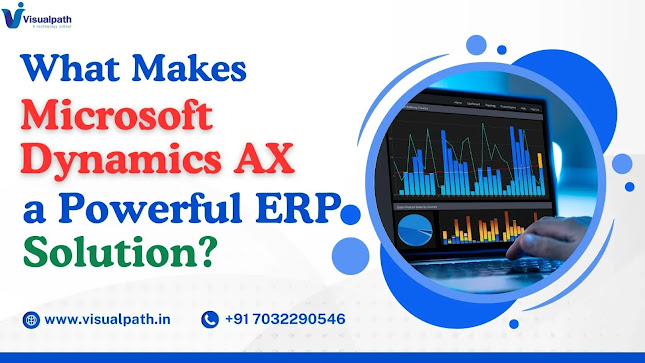In 2025, Microsoft
Dynamics AX remains one of the most powerful tools for businesses
worldwide. As companies strive to stay competitive, streamlining processes and
improving efficiency are top priorities. Microsoft Dynamics AX is playing a
crucial role in achieving these goals. The platform has evolved over the years,
adapting to changing business needs. In this blog, we will explore how Microsoft Dynamics AX simplifies
business processes in 2025 and how it helps organizations stay ahead of the
curve.
The Evolution of
Microsoft Dynamics AX
Over the past
decade, Microsoft Dynamics AX
has undergone significant transformations. Originally launched in the early
2000s, it was designed to help companies manage operations and financials. By
2025, the software has matured into a highly advanced ERP system, helping
businesses automate key processes such as accounting, inventory management, and
customer relationship management (CRM).
The most recent
version, Dynamics
365 Finance and Operations, was released in 2022 and further expanded
its capabilities. The transition from Microsoft
Dynamics AX to Dynamics 365
introduced a cloud-based infrastructure, making it more scalable, flexible, and
accessible. With real-time data analytics, AI integration, and an intuitive
user interface, it’s easier for companies to make informed decisions faster.
Microsoft Dynamics
AX 2025: Cloud Adoption and Scalability
One of the primary
reasons for the continued success of Microsoft
Dynamics AX is its seamless integration with the cloud. By 2025, the
platform has become fully optimized for cloud environments, ensuring
scalability, security, and accessibility. Cloud-based
ERP systems are becoming the
norm as businesses look for solutions that allow them to scale operations
without hefty upfront investments in hardware.
By leveraging the
cloud, businesses can access their data from anywhere, improving collaboration
across teams. With Microsoft Azure
as its backbone, Dynamics AX
ensures data security, compliance, and disaster recovery options, which are
crucial for modern enterprises.
Artificial
Intelligence (AI) and Automation
AI is a central
theme in the evolution of Microsoft
Dynamics AX. With AI-driven capabilities, businesses can automate
routine tasks, predict market trends, and streamline decision-making processes.
The inclusion of machine learning and predictive analytics helps companies in
forecasting demand, optimizing supply chains, and improving customer service.
In 2025, AI integration in Microsoft Dynamics AX has reached new
heights. Businesses now benefit from personalized customer experiences,
automated invoice processing, and intelligent inventory management. This
reduces manual work, improves operational efficiency, and frees up time for
employees to focus on strategic initiatives.
Real-Time Data
Analytics
Data is one of the
most valuable assets in today’s business landscape. With Microsoft Dynamics AX, companies can
leverage real-time data analytics to gain insights into their operations,
customers, and financial performance. This allows business leaders to make
quicker, more accurate decisions based on up-to-the-minute data.
Real-time analytics
help businesses identify trends and patterns that might otherwise go unnoticed.
This leads to better decision-making in areas such as pricing, inventory
management, and product development. The integration of Power BI with Microsoft Dynamics AX makes data
visualization even more powerful, allowing businesses to create interactive
dashboards for better decision support.
Enhanced
Collaboration and Integration
Collaboration
across departments is essential for any successful business. With Microsoft Dynamics AX, companies can
break down silos and foster collaboration between teams. By connecting
different parts of the business, such as finance, supply chain, and sales, the
platform ensures that all stakeholders have access to the same information.
Moreover, Dynamics
AX integrates seamlessly with other Microsoft products, such as Microsoft
Office 365, Teams, and SharePoint, which enhances
communication and collaboration among employees. Integration with third-party
applications and services further expands its capabilities, making it an
all-in-one solution for businesses of all sizes.
Improved Customer
Experience
Customer
satisfaction is at the heart of any successful business strategy. Microsoft
Dynamics AX helps organizations manage customer relationships more
effectively. With its CRM
capabilities, businesses can track interactions, monitor service requests, and
manage sales leads. This ensures that customers receive timely support and
personalized experiences, which are crucial for building long-term
relationships.
In 2025, the
platform's customer insights
tools are more powerful than ever. AI and machine learning enable businesses to
deliver hyper-personalized experiences based on customer behaviour,
preferences, and purchasing patterns. This boosts customer loyalty and drives
revenue growth.
Cost Efficiency and
ROI
One of the most
significant advantages of Microsoft
Dynamics AX in 2025 is its ability to help businesses reduce costs and
improve their return on investment (ROI). The software automates many manual
processes, such as inventory tracking and accounting, resulting in lower
operational costs.
By reducing errors,
improving efficiency, and offering better visibility into financial
performance, businesses can make smarter financial decisions. This helps them
allocate resources more effectively and drive profitability. With its advanced
analytics and forecasting tools, Microsoft
Dynamics AX enables organizations to identify cost-saving opportunities
and make data-driven financial decisions.
Conclusion
In 2025, Microsoft Dynamics AX continues to be
an essential tool for businesses aiming to streamline operations and improve
efficiency. Through cloud adoption, AI integration, real-time analytics, and
enhanced collaboration, the platform empowers organizations to stay competitive
in a rapidly changing business landscape.
By embracing the
full capabilities of Microsoft Dynamics AX, companies can simplify
complex processes, reduce costs, and enhance customer experiences. As the
platform continues to evolve, it will remain a key enabler of business success
for years to come.
Trending Courses : Snowflake Course, Sailpoint Identity IQ, Dynamics
365 Supply Chain Management
Visualpath is the Leading and Best Institute for
learning in Hyderabad. We provide MicroSoft Dynamics Ax
Training in India. You will get the best course at an affordable cost.
For more Details Contact +91 7032290546
Visit:
https://www.visualpath.in/online-microsoft-dynamics-ax-technical-training.html






